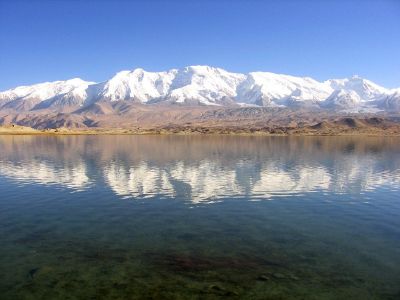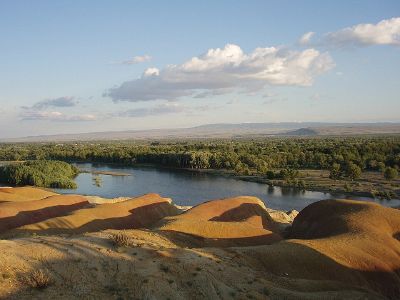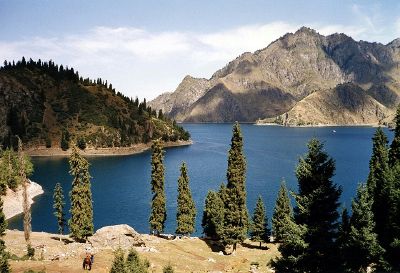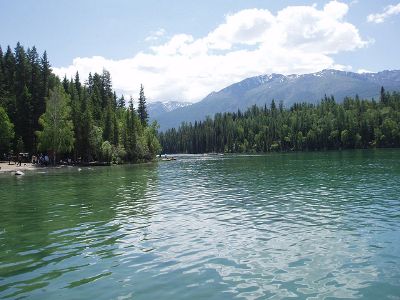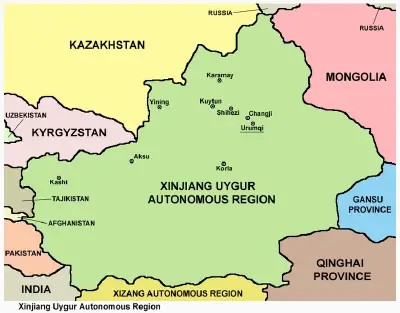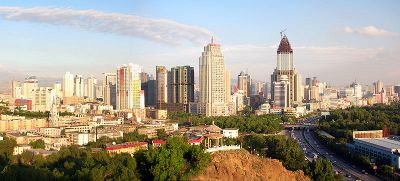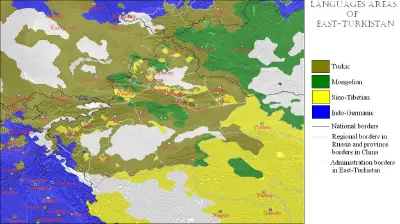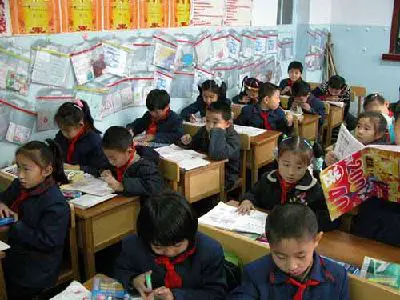Xinjiang
| Xinjiang Uygur Autonomous Region Uyghur: Ø´ÙÙØ¬Ø§Ú Ø¦ÛÙغÛر ئاپتÙÙÙ٠راÙÙÙÙ (Xinjang Uyghur Aptonom Rayoni) Chinese:æ°çç»´å¾å°èªæ²»åº (XÄ«njiÄng Wéiwú'Är ZìzhìqÅ«) | |
| Abbreviations: æ°Â (Pinyin: XÄ«n) | |
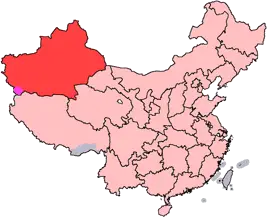
| |
| Origin of name | æ° xÄ«n â new ç jiÄng â frontier "new frontier" |
| Administration type | Autonomous region |
| Capital | Ãrümqi |
| CPC Ctte Secretary | Ma Xingrui |
| Chairman | Erkin Tuniyaz |
| Area | 1,660,001 km² (1st) |
| Population (2021) Â - Density |
25,890,000 (21st) 16/km² (29th) |
| GDP (2023) Â - per capita |
CNYÂ 1,913 billion US$ 271 billion (23rd) CNYÂ 73,774 US$ 10,469 (16th) |
| HDI (2022) | 0.762Â (high)Â (22nd) |
| Major nationalities | Uyghur â 45% Han â 41% Kazakh â 7% Hui â 5% Kyrgyz â 0.9% Mongol â 0.8% Dongxiang â 0.3% Pamiris â 0.2% Xibe â 0.2% |
| Prefecture-level | 14Â divisions |
| County-level | 99Â divisions |
| Township-levelâ | 1005Â divisions |
| ISO 3166-2 | CN-65 |
| Official website Chinese Uyghur version | |
Xinjiang is an autonomous region of the People's Republic of China, officially the Xinjiang Uygur Autonomous Region (XUAR). It is a large, sparsely populated area which takes up about one sixth of the country's territory. Xinjiang borders three provinces of China including the Tibet Autonomous Region to the south and Qinghai and Gansu provinces to the southeast. In addition, it borders eight separate countries: Mongolia to the east, Russia to the north, and Kazakhstan, Kyrgyzstan, Tajikistan, Afghanistan, Pakistan, and India to the west. It administers most of Aksai Chin under the authority of the People's Republic of China, although the region is claimed by India as part of the state of Jammu and Kashmir. Xinjiang's central position in the region, and the active presence of Islamic faithful, make the province a pivotal region for peace and prosperity in the area.
"Xinjiang" or "Ice Jecen" in Manchu, literally means "New Frontier," a name given during the Manchu Qing Dynasty in China. It is home to a number of Turkic ethnic groups, the largest of which are the Uyghurs. The region is often referred to as Chinese Turkestan or East Turkestan, due to its ethnic links to Central Asia and specifically Turkestan. This strong linkage, combined with the high population of Uyghurs in the region has also led to a push for an independent Xinjiang, sometimes referred to as Uyghuristan by Uyghur activists. Separatist conflict and the influence of radical Islam resulted in unrest in the region with occasional terrorist attacks and clashes between separatist and government forces. These conflicts prompted the Chinese government to commit a series of ongoing human rights abuses against Uyghurs and other ethnic and religious minorities in the province.
History
Xinjiang has historically been an important area in Asia, due to its geographically significant location at the center of the continent. Throughout its history, a succession of conquerers and traders have passed through the area, many of whom challenged Chinese control of the region.
In 60 B.C.E., Xinjiang became part of China's territory when the central government of the Western Han Dynasty founded the West Region Frontier Command there. In 1884, the government of the Qing Dynasty officially established Xinjiang as a province. On October 1, 1955, it was declared the Xinjiang Uygur Autonomous Region by the People's Republic of China.
Historic names
Once part of Western Regions, the area was later known as East Turkestan. As part of the People's Republic of China, the official name of the region today is the Xinjiang Uyghur Autonomous Region, although it is often called Xin for short. Among Uyghur activists who seek independence from China, the region is also referred to as Uyghuristan.
Geography and geology
The geographic position of Xinjiang makes it a very important location strategically. In history, Xinjiang served as the key controlling section of the well-known Silk Road, while it is now a crucial segment of the railway leading to the second Eurasia Continental Bridge.ã
Xinjiang is the largest political subdivision of China, with an area of 1.66 million km². It accounts for more than one-sixth of China's total territory and a quarter of its total boundary length. It is divided into two parts by Mount Tianshan with the parts traditionally being referred to as North Xinjiang (north of the Tianshan mountains), and South Xinjiang (south of the Tianshan mountains). Dzungarian Basin lies to the north, and Tarim Basin lies to the south within this divide. In the center part of Tarim Basin stretches the Taklimakan Desert, the largest mobile desert in China and the second largest in the world. Xinjiang's lowest point is the Turfan Depression, which is 155 meters below sea level and also serves as the lowest point in all of China. Its highest peak, K2, stands on the border of Xinjiang and Kashmir, and at 8,611 meters above sea level, is the second highest mountain on earth.
Most of Xinjiang is young geologically, having been formed from the collision of the Indian plate with the Eurasian plate, forming the Tian Shan, Kunlun Shan, and Pamir mountain ranges. Consequently, Xinjiang is a major earthquake zone. Older geological formations occur principally in the far north, where the Junggar Block is geologically part of Kazakhstan, and in the east, which is part of the North China Craton.
The Eurasian pole of inaccessibility, the point on land farthest from any ocean, is located approximately 320 km (200 miles) from the city of Urumqi, within the boundary of Xinjiang. It is located at Lat. 46 degrees 16.8 minutes N, Long. 86 degrees 40.2 minutes E, in the Dzoosotoyn Elisen Desert, which is 1,645 miles (2648 km) from the nearest coastline (in straight-line distance).
The Tian Shan (Tengri Tagh in Uyghur meaning mountains of the spirits) mountain range marks the Xinjiang-Kyrgyzstan border at the Torugart Pass (3752 m). The famous Karakorum highway (KKH) known as the "highway in the clouds" links Islamabad, Pakistan with Kashgar over the Khunjerab Pass. to the Chinese, it is referred to as "Friendship Highway."
Rivers and lakes
Having hot summer and low precipitation, most of Xinjiang is endorheic. Its rivers either disappear in the desert, or terminate in salt lakes (within Xinjiang itself, or in neighboring Kazakhstan), instead of running towards an ocean. The northernmost part of the region, with the Irtysh River rising in the Altai Mountains, that flows (via Kazakhstan and Russia) toward the Arctic Ocean, is the only exception. But even so, a significant part of the Irtysh's waters were artificially diverted via the IrtyshâKaramayâÃrümqi Canal to the drier regions of southern Dzungarian Basin.
Elsewhere, most of Xinjiang's rivers are comparatively short streams fed by the snows of the several ranges of the Tian Shan. Once they enter the populated areas in the mountains' foothills, their waters are extensively used for irrigation, so that the river often disappears in the desert instead of reaching the lake to whose basin it nominally belongs. This is the case even with the main river of the Tarim Basin, the Tarim, which has been dammed at a number of locations along its course, and whose waters have been completely diverted before they can reach the Lop Lake. In the Dzungarian basin, a similar situation occurs with most rivers that historically flowed into Lake Manas. Some of the salt lakes, having lost much of their fresh water inflow, are now extensively use for the production of mineral salts (used e.g., in the manufacturing of potassium fertilizers); this includes the Lop Lake and the Manas Lake.
Deserts
Deserts include:
- Gurbantünggüt Desert, also known as Dzoosotoyn Elisen
- Taklamakan Desert
- Kumtag Desert, east of Taklamakan
Major cities
Due to water scarcity, most of Xinjiang's population lives within fairly narrow belts that are stretched along the foothills of the region's mountain ranges in areas conducive to irrigated agriculture. It is in these belts where most of the region's cities are found.
Major Cities:
- Urumqi
- Yining
- Kuytun
- Karamay
- Kashi
- Shihezi
- Changji
- Aksu
- Korla
Administrative divisions
Xinjiang is divided into thirteen prefecture-level divisions: four prefecture-level cities, six prefectures and five autonomous prefectures (including the sub-provincial autonomous prefecture of Ili, which in turn has two of the seven prefectures within its jurisdiction) for Mongol, Kazakh, Kyrgyz, and Hui minorities.
These are then divided into 13 districts, 29 county-level cities, 62 counties and 6 autonomous counties. Twelve of the county-level cities do not belong to any prefecture and are de facto administered by the Xinjiang Production and Construction Corps (XPCC).
Economy
Xinjiang is known for its fruits and produce, including grapes, melons, pears, cotton, wheat, silk, and walnuts. In addition, it has large deposits of gold, chromium, copper, nickel, rare metals, salts, and nonmetals for building. Xinjiang also has deposits of coal and oil, making it both an economically and strategically significant area for the People's Republic of China.
The Xinjiang Production and Construction Corps (XPCC) is an important part of Xinjiang's economy, with 174 regimental agricultural and stockbreeding farms operating under it.
Xinjiang's nominal GDP was approximately 187 billion RMB (about 23 billion USD) in 2003, and increased to 220 billion RMB (about 28 billion USD) in 2004, due to the China Western Development policy introduced by the State Council to boost economic development in Western China. Its per capita GDP for 2003 was 9,710 RMB (1172 USD).
Oil and gas extraction in the prefectures of Aksu and Karamay is booming, especially with the West-East Gas Pipeline connecting all the way to Shanghai on China's eastern coast. Along with this oil and gas boom, the predicted reserve of coal in Xinjiang is 2.19 trillion tons, accounting for 40 percent of the total of the entire country. This abundance of resources makes the province an incredibly important source of energy for China.
Xinjiang's exports amounted to 3.047 billion USD, while imports turned out to be 2.589 billion USD in 2004. Most of the overall import/export volume in Xinjiang was directed to and from Kazakhstan through Ala Pass. China's first border free trade zone (Horgos Free Trade Zone) was located at the Xinjiang-Kazakhstan border city of Horgos. Horgos is the largest land port in China's western region and has easy access to the Central Asian market. In March 2006, Xinjiang will also open its second border trade market to Kazakhstan, which will be called the Jeminay Border Trade Zone.
Demographics
Xinjiang is home to 47 different ethnic groups, including several Muslim Turkic groups such as the Uyghurs and the Kazakhs. Uyghurs make up nearly half of the population, which makes Xinjiang very different demographically from other parts of mainland China, and has led to its official designation as an autonomous region for ethnic minorities. Along with the Uyghurs and Kazakhs, other minority ethnic groups in Xinjiang include Hui Chinese, the Kirgiz, the Mongols, the Russians, the Xibes, the Tajiks, the Uzbeks, the Tatars, the Daurs, and the Manchus.
The percentage of ethnic Han Chinese (the majority ethnic group of China) in Xinjiang has grown from 6 percent in 1949 to an official tally of over 40 percent at present. This figure does not include military personnel or their families, or the many unregistered migrant workers who have come into Xinjiang from other parts of the country. Much of this demographic transformation can be attributed to the Xinjiang Production and Construction Corps (XPCC), a semi-military organization of settlers that has built farms, towns, and cities over scattered parts of Xinjiang. The demographic shift is seen by Uyghur independence advocates as a threat to Uyghurs and other non-Han ethnicities in maintaining their distinct culture within Chinese society, similar to the case of Tibet. At the same time, the minorities of Xinjiang have been historically exempted from the One-Child Policy, and many Uyghurs have emigrated out of Xinjiang to other parts of China, causing the percentage of Uyghur people in the total population of China to increase steadily.
In general, Uyghurs are the majority in Southwestern Xinjiang, including the prefectures of Kashgar, Khotan, Kizilsu, and Aksu, as well as Turpan prefecture in eastern Xinjiang. Han Chinese are the majority in eastern and northern Xinjiang, including the cities of Urumqi, Karamay, Shihezi and the prefectures of Changji, Bortala, Bayin'gholin, Ili (especially the city of Kuitun), and Kumul. Kazakhs are mostly concentrated in Ili prefecture in northern Xinjiang.
Some Uyghur scholars claim descent from both the Turkic Uyghurs and the pre-Turkic Tocharians (or Tokharians, whose language was Indo-European). Relatively fair-skin, hair, and eyes, as well as other so-called 'Caucasoid' physical traits are not uncommon among these individuals. However, generally Uyghurs usually resemble individuals from neighboring countries, including those from Afghanistan, Kyrgyzstan, Uzbekistan, Kazakhstan, and Pakistan.
Human rights abuses
The Chinese government, under Chinese Communist Party general secretary Xi Jinping's administration, launched the Strike Hard Campaign Against Violent Terrorism in 2014, which involved mass detention and surveillance of ethnic Uyghurs there.[1] The program was massively expanded by Chen Quanguo when he was appointed as CCP Xinjiang secretary in 2016. The campaign included the detainment of 1.8 million people in internment camps, mostly Uyghurs, but also including other ethnic and religious minorities, by 2020.[2] An exposé in by BBC News claimed, based on analysis of satellite imagery collected over time, that hundreds of thousands of Uyghurs were likely interned in the camps, and they were rapidly being expanded.[3] In 2019, The Art Newspaper reported that "hundreds" of writers, artists, and academics had been imprisoned in (what the magazine qualified as) an attempt to "punish any form of religious or cultural expression" among Uyghurs.[4] China has also been accused of targeting Muslim religious figures, Mosques and tombs in the region.[5] This program has been called a genocide by some observers, while a report by the UN Human Rights Office said they may amount to crimes against humanity.[6][7]
On June 28, 2020, the Associated Press published a report which stated the Chinese government was taking draconian measures to slash birth rates among Uyghurs and other Muslim minorities in Xinjiang, even as it encouraged some of the country's Han majority to have more children.[8] While individual women have spoken out before about forced birth control, the practice was far more widespread and systematic than previously known, according to an AP investigation based on government statistics, state documents and interviews with 30 ex-detainees, family members and a former detention camp instructor. The campaign over the past four years in Xinjiang has been labeled by some experts as a form of "demographic genocide."[8]
Education
In the early years after the founding of the People's Republic of China, the average educational level for the population aged six and above in Xinjiang was less than grade one of primary school. By 1990, the average number of years of education for the population aged six and above was 6.52 years.
The focus of the literate population in Xinjiang has gradually transferred from education at the primary school level to that of junior and senior middle school. However, the percentage of the population with solely a primary school education still accounts for more than half of the total population. Although the number of intellectuals with a college and/or university education has been increasing very rapidly during recent years, the proportion of the group is still very small in terms of the total population. Compared with the provinces and autonomous regions with advanced economic development in China, there is still a noticeable gap.
With the deepening of China's transformation and open policy, the cultural and educational undertakings in Xinjiang have developed greatly. According to statistics at the end of 2000, in Xinjiang there were 20 colleges and universities; 2,000 secondary schools; and 6,718 primary schools.
Xinjiang's educational system is continuing to develop as the People's Republic of China invests more into its northwest region. Consequently, basic education levels are being improved within Xinjiang, and various adult education approaches are also being developed.
Media
The Xinjiang Networking Transmission Limited operates the Urumqi People Broadcasting Station and the Xinjiang People Broadcasting Station, broadcasting in Mandarin (dialect), Uyghur (dialect), Kazak and Mongolian.
Sports
Xinjiang is home to the Xinjiang Flying Tigers professional basketball team of the Chinese Basketball Association, and to Xinjiang Tianshan Leopard F.C., a football team that plays in China League One.
The capital, Ãrümqi, is home to the Xinjiang University baseball team.
Notes
- â [Christian Shepherd, Fear and oppression in Xinjiang: China's war on Uighur culture Financial Times, September 12. 2019. Retrieved June 21, 2025.
- â Raffi Khatchadourian, Surviving the Crackdown in Xinjiang The New Yorker, April 5, 2021. Retrieved June 21, 2025.
- â John Sudworth, China's hidden camps BBC News, October 24, 2018. Retrieved June 21, 2025.
- â Lisa Movius, 'Hundreds' of cultural figures caught up in Chinaâs Uyghur persecution The Art Newspaper, January 2, 2019. Retrieved June 21, 2025.
- â Who are the Uyghurs and why is China being accused of genocide? BBC News, May 24, 2022. Retrieved June 21, 2025.
- â China's Xi responsible for Uyghur 'genocide', unofficial tribunal says Reuters, December 10, 2021. Retrieved June 21, 2025.
- â Emma Farge, U.N. says China may have committed crimes against humanity in Xinjiang Reuters, September 1, 2022. Retrieved June 21, 2025.
- â 8.0 8.1 China cuts Uighur births with IUDs, abortion, sterilization The Associated Press, June 29, 2020. Retrieved June 21, 2025.
ReferencesISBN links support NWE through referral fees
- Ogden, Suzanne.Global Studies: China. Dubuque, Iowa: McGraw-Hill, 2006. ISBN 0073198722
- Soucek, Svatopluk. A History of Inner Asia. Cambridge: Cambridge University Press, 2000. ISBN 978-0521651691
- Starr, S. Frederick. Xinjiang: China's Muslim Borderland. Armonk, NY: M.E. Sharpe Inc., 2004. ISBN 978-0765613172
External links
All links retrieved June 21, 2025.
- Photo gallery from CBC.ca.
- Xinjiang profile BBC.
- China (Includes Tibet, Xinjiang, Hong Kong, and Macau): Xinjiang U.S. Department of State.
- Chinaâs Repression of Uyghurs in Xinjiang Council on Foreign Relations.
- Historical Overview of Events Shaping the Politics of Xinjiang Xinjiang Documentation Project, University of British Columbia.
| Province-level divisions administered by the People's Republic of China (PRC) | |
|---|---|
| Provinces | Anhui · Fujian · Gansu · Guangdong · Guizhou · Hainan · Hebei · Heilongjiang · Henan · Hubei · Hunan · Jiangsu · Jiangxi · Jilin · Liaoning · Qinghai · Shaanxi · Shandong · Shanxi · Sichuan · Taiwan · Yunnan · Zhejiang |
| Autonomous regions | Guangxi · Inner Mongolia · Ningxia · Tibet (Xizang) · Xinjiang |
| Municipalities | Beijing · Chongqing · Shanghai · Tianjin |
| Special administrative regions | Hong Kong · Macau |
Credits
New World Encyclopedia writers and editors rewrote and completed the Wikipedia article in accordance with New World Encyclopedia standards. This article abides by terms of the Creative Commons CC-by-sa 3.0 License (CC-by-sa), which may be used and disseminated with proper attribution. Credit is due under the terms of this license that can reference both the New World Encyclopedia contributors and the selfless volunteer contributors of the Wikimedia Foundation. To cite this article click here for a list of acceptable citing formats.The history of earlier contributions by wikipedians is accessible to researchers here:
The history of this article since it was imported to New World Encyclopedia:
Note: Some restrictions may apply to use of individual images which are separately licensed.
